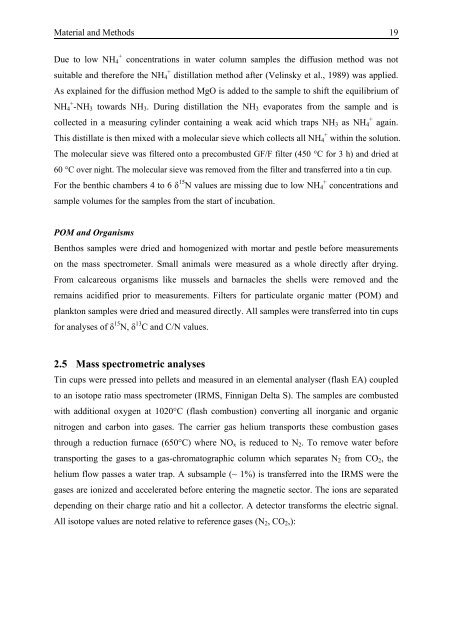Poland - IOW
Poland - IOW
Poland - IOW
You also want an ePaper? Increase the reach of your titles
YUMPU automatically turns print PDFs into web optimized ePapers that Google loves.
Material and Methods 19<br />
Due to low NH + 4 concentrations in water column samples the diffusion method was not<br />
suitable and therefore the NH + 4 distillation method after (Velinsky et al., 1989) was applied.<br />
As explained for the diffusion method MgO is added to the sample to shift the equilibrium of<br />
NH + 4 -NH 3 towards NH 3 . During distillation the NH 3 evaporates from the sample and is<br />
collected in a measuring cylinder containing a weak acid which traps NH 3 as NH + 4 again.<br />
This distillate is then mixed with a molecular sieve which collects all NH + 4 within the solution.<br />
The molecular sieve was filtered onto a precombusted GF/F filter (450 °C for 3 h) and dried at<br />
60 °C over night. The molecular sieve was removed from the filter and transferred into a tin cup.<br />
For the benthic chambers 4 to 6 δ 15 N values are missing due to low NH + 4 concentrations and<br />
sample volumes for the samples from the start of incubation.<br />
POM and Organisms<br />
Benthos samples were dried and homogenized with mortar and pestle before measurements<br />
on the mass spectrometer. Small animals were measured as a whole directly after drying.<br />
From calcareous organisms like mussels and barnacles the shells were removed and the<br />
remains acidified prior to measurements. Filters for particulate organic matter (POM) and<br />
plankton samples were dried and measured directly. All samples were transferred into tin cups<br />
for analyses of δ 15 N, δ 13 C and C/N values.<br />
2.5 Mass spectrometric analyses<br />
Tin cups were pressed into pellets and measured in an elemental analyser (flash EA) coupled<br />
to an isotope ratio mass spectrometer (IRMS, Finnigan Delta S). The samples are combusted<br />
with additional oxygen at 1020°C (flash combustion) converting all inorganic and organic<br />
nitrogen and carbon into gases. The carrier gas helium transports these combustion gases<br />
through a reduction furnace (650°C) where NO x is reduced to N 2 . To remove water before<br />
transporting the gases to a gas-chromatographic column which separates N 2 from CO 2 , the<br />
helium flow passes a water trap. A subsample (~ 1%) is transferred into the IRMS were the<br />
gases are ionized and accelerated before entering the magnetic sector. The ions are separated<br />
depending on their charge ratio and hit a collector. A detector transforms the electric signal.<br />
All isotope values are noted relative to reference gases (N 2 , CO 2 ,):
















